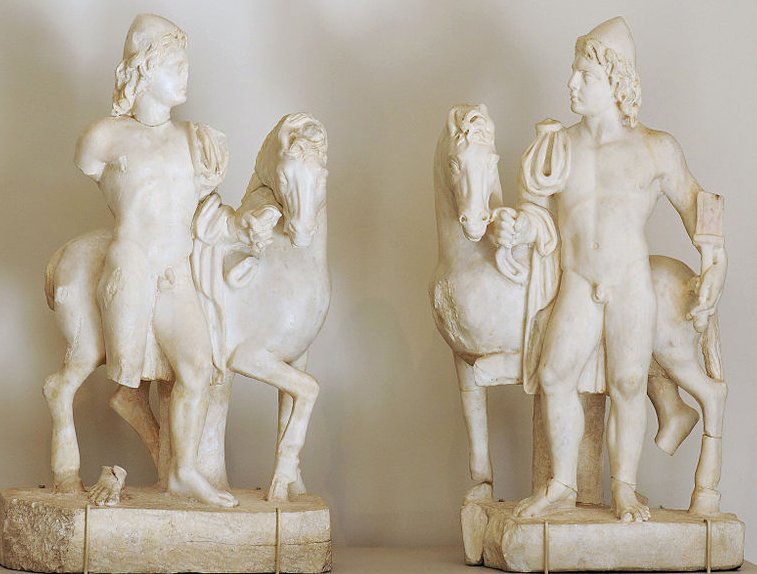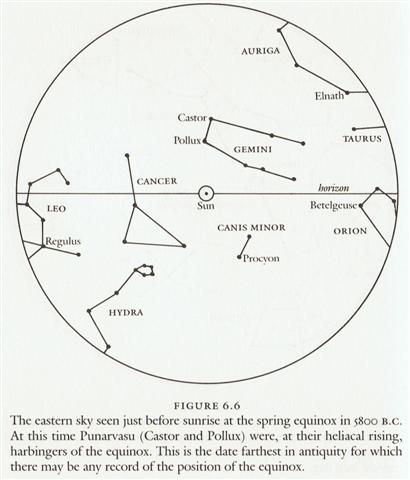5. When we are increasing the right ascension values for the stars we are moving in time. I do not mean the fact that they each day rise in the order given by their right ascension numbers, the stars with low ascension values rising earlier than those with higer values, but also descending earlier. Neither do I refer to how Sun will rise together with the stars in the succession given by their right ascension numbers, at spring equinox (north of the equator) together with stars which (like Sirrah) have values close to 0h and later 'visiting' the stars with higher values, and completing the cycle of 24h at next spring equinox. Instead I refer to the fact that when we put in parallel the glyphs in G with the stars in our list, with higher glyph numbers corresponding to higher right ascension numbers, we will go farther and farther back in time when we move ahead in the text:
Hamal, for instance, is - according to my correlations - rising 2 days later than Alrisha, which means Hamal rose heliacally at equinox about 2 / 365╝ * 26000 = 142 years earlier than Alrisha.
Polaris (and several other prominent stars) is located 436 - 408 = 28 days later than spring equinox (north of the equator), which translates to ca 28 / 365╝ * 26000 = 1993 years ago. Thus Hamal was at equinox around twice 142 + 1993 = 2277 years ago. However, we must remember (cfr at Camp 5), that we have not yet been able to determine if the glyphs in the G text really refer to heliacal risings of stars or whether the stars were used for full moon positions according to the nakshatra method for determining the location of Sun: ... The system of Nakshatras, then, is quite distinct from systems that use the appearance of heliacally rising or setting stars as the equinoctial marker. Furthermore, the Indian system is all but unique in that two calendar systems competed with each other - a civil system, in which the year's beginning was at the winter solstice, and a sacrificial year, which begins at the spring equinox. The beginning of the former was determined by the Nakshatra method, observing the winter full moon's apparition near the point of the summer solstice in the sky (as explained above). The arrival of the beginning of the sacrificial year might be determined by the Nakshatra method - observation of the spring full moon near to the autumn Nakshatra in Virgo. More commonly, however, it was determined as in the Greek system, by direct observation of the heliacal rising of a sign star. In the current calendar, for example - one unchanged since the fifth century A.D. - the yoga star of the Nakshatra Ashvini (beta Arietis) ushers in the spring equinox at its heliacal rising ...
... Sharatan and Sheratan are from Al Sharatain, the dual form of Al Sharat, a Sign, referring to this and γ, the third star in the head, as a sign of the opening year; β having marked the vernal equinox in the days of Hipparchos, about the time when these stars were named. Bayer's Sartai is from this dual word ... ... β and γ constituted the 27th 'nakshatra' Ašvini, the Ashwins, or Horsemen, the earlier dual Ašvināu and Ašvayujāu, the Two Horsemen, corresponding to the Gemini of Rome, but figured as a Horse's Head.
... α sometimes was added to this lunar station, but β always was the junction star with the adjoining Bharani. About 400 years before our era this superseded Krittika as the leader of the 'nakshatras' ... This is one more example, I think, of how the ideas of old are updated to fit new circumstances. The pair of horsemen are presumably adaptations based on Castor and Pollux.
|




